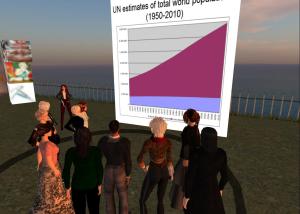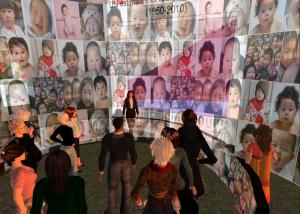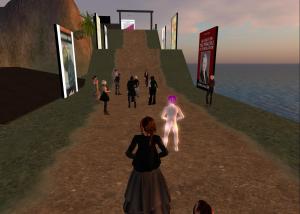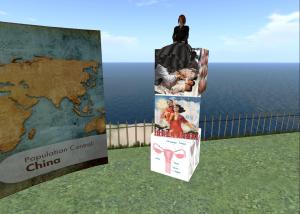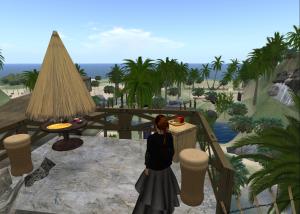As part of a project with Tufts University School of Medicine, my colleague, Liz Dorland (SL = Chimera Cosmos) and I (SL = Spiral Theas) set out to design a new learning space for their Service Scholars Program. Their requirements were:
– A comfortable meeting space for medical residents to gather and chat
– An amphitheater-style setting for special events, speakers, and presentations
– Small, private group settings for role-play practice
We inherited a Second Life island from a previous Tufts University urban planning project where students worked to create and test various city plans. Since the current landowners had completed their project, they were fine with us taking apart anything on the island and refashioning it as we wished. They generously shared their administrative rights and privileges with us and, with our newly bestowed super powers and nothing but empty road ahead, we dug in.
This is how the island looked when we took possession:
So the first order of business was to come into Second Life as their administrator avatar and take apart the streets, houses, roads, and landscaping.
We created our own, new administrative avatar: Dr. Care. She would be the keeper of any materials, textures, equipment or scripts that we used to build out the new space. That way, when our new project concludes, we can turn the avatar over to the folks at Tufts and they will have full access to anything they might need.
Next up, we did some touring around to figure out what kind of space to develop. What look and feel would best suit the needs of these learners? Since Liz and I have done a lot of healthcare education work together in Second Life, we already knew that we’d prefer an outdoor setting. Fewer buildings mean fewer doorways, stairways, and a lot less location-confusion and tricky navigation for new avatars.
Liz is a big fan of the designer Alex Bader. After visiting a few places in Second Life that feature his designs, I could see why. He has a wonderful eye and produces lovely foresty glens, river walk ways, magical looking bridges, and realistic looking beaches (with waves). On his web site you can see the range of textures, buildings, and landscapes he creates. His work has a tasteful, ethereal quality to it that just seems to signal you are in a special place. We thought it would be perfect for this group of medical students – restful, welcoming, and open.
Dr. Care purchased the River Bank Building set and Liz set to work on the terraforming. For those of you who’s not yet experimented with terraforming in a virtual environment – it’s great fun. Raising and lowering mountains, carving out rivers, smoothing over grasslands….it gives you a tremendous sense of power.
We used the waterways and mountains to apportion the island into roughly five areas (shown below on our island map):
the amphitheater (in the center of the island), the three small group areas (red, green and blue) and an exhibits area for the future. We also carved out a gently sloping landing area, where people will teleport in, that affords a peekaboo view of the amphitheater up ahead. We plopped a welcoming gazebo in that spot.
While most of our participants will most likely teleport from venue to venue on the island, we also wanted to build paths between locations. Liz laid down the lovely Bader River Walk paths seen below. A tricky proposition to get the leveling right, positioning boulders and mossy banks in order for it to look realistic.
In the distance, you can see a waterfall, which marks the location of the main amphitheater. Waterfalls add a lovely visual element as well as a gentle and soothing background sound. Also note the trees in these photos – we went with birch, spruce, and pines. They seemed to fit with the general feeling of the place.
Next up we shopped around for the right seating options. We wanted attractive, outdoor-style seats, complete with automatic sit poses (helpful for new avatars). These wooden garden benches fit the bill:
We installed a Pres-o-matic screen (made to look a bit more rustic with a newly created wooden frame) and web viewer, along with a slight stage area for the speakers and stools to perch on.
The small group areas are outfitted with a campfire circle (logs with sit poses) that Liz had in her inventory and a display screen. Comfortable and simple.
Around this time, Liz was hankering for a proper beach – and look what she nimbly created on the west side of the island.
It seemed a shame to see the beautiful waterways on our island with no way to travel on them, so in went a playful canoe. Boats rez on demand from a sign at the dock and, once seated, you have a number of passenger sitting pose options (fishing, reading, or dangling your hand in the water) and of course, you have your oars, if you are the rower.
We managed to traverse all of our new rivers as well as circumnavigate the island without incident.
So, at last, we are ready to open the island to the students. Since this is a private island, visitors must be given access by the island administrator. We’re looking forward to working with the residents to see their use their new space and what accommodations and modifications to make over time as they make it their own.
















